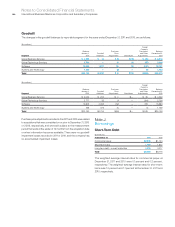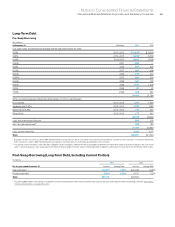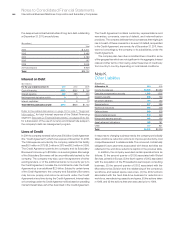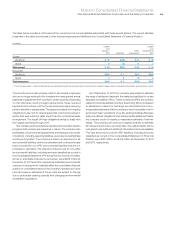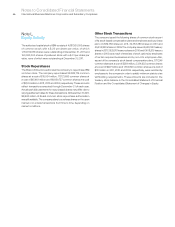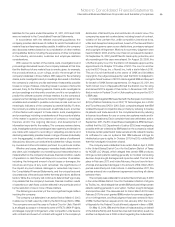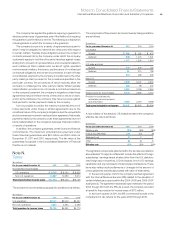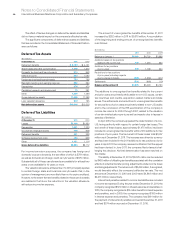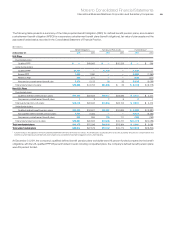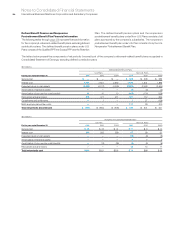IBM 2011 Annual Report Download - page 117
Download and view the complete annual report
Please find page 117 of the 2011 IBM annual report below. You can navigate through the pages in the report by either clicking on the pages listed below, or by using the keyword search tool below to find specific information within the annual report.
Notes to Consolidated Financial Statements
International Business Machines Corporation and Subsidiary Companies 115
The company has applied the guidance requiring a guarantor to
disclose certain types of guarantees, even if the likelihood of requiring
the guarantor’s performance is remote. The following is a description
of arrangements in which the company is the guarantor.
The company is a party to a variety of agreements pursuant to
which it may be obligated to indemnify the other party with respect
to certain matters. Typically, these obligations arise in the context of
contracts entered into by the company, under which the company
customarily agrees to hold the other party harmless against losses
arising from a breach of representations and covenants related to
such matters as title to assets sold, certain IP rights, specified
environmental matters, third-party performance of nonfinancial
contractual obligations and certain income taxes. In each of these
circumstances, payment by the company is conditioned on the other
party making a claim pursuant to the procedures specified in the
particular contract, the procedures of which typically allow the
company to challenge the other party’s claims. While typically
indemnification provisions do not include a contractual maximum
on the company’s payment, the company’s obligations under these
agreements may be limited in terms of time and/or nature of claim,
and in some instances, the company may have recourse against
third parties for certain payments made by the company.
It is not possible to predict the maximum potential amount of
future payments under these or similar agreements due to the
conditional nature of the company’s obligations and the unique facts
and circumstances involved in each particular agreement. Historically,
payments made by the company under these agreements have not
had a material effect on the company’s business, financial condition
or results of operations.
In addition, the company guarantees certain loans and financial
commitments. The maximum potential future payment under
these financial guarantees was $42 million and $48 million at
December 31, 2011 and 2010, respectively. The fair value of the
guarantees recognized in the Consolidated Statement of Financial
Position is not material.
Note N.
Ta xe s
($ in millions)
For the year ended December 31: 2011 2010 2009
Income before income taxes
U.S. operations $ 9,716 $ 9,140 $ 9,524
Non-U.S. operations 11,287 10,583 8,614
Total income before income taxes $21,003 $19,723 $18,138
The provision for income taxes by geographic operations is as follows:
($ in millions)
For the year ended December 31: 2011 2010 2009
U.S. operations $2,141 $2,000 $2,427
Non-U.S. operations 3,007 2,890 2,286
Total provision for income taxes $5,148 $4,890 $4,713
The components of the provision for income taxes by taxing jurisdiction
are as follows:
($ in millions)
For the year ended December 31: 2011 2010 2009
U.S. federal
Current $ 268 $ 190 $ 473
Deferred 909 1,015 1,341
1,177 1,205 1,814
U.S. state and local
Current 429 279 120
Deferred 81 210 185
510 489 305
Non-U.S.
Current 3,239 3,127 2,347
Deferred 222 69 247
3,461 3,196 2,594
Total provision for income taxes 5,148 4,890 4,713
Provision for social security,
real estate, personal property
and other taxes 4,289 4,018 3,986
Total taxes included in net income $9,437 $8,908 $8,699
A reconciliation of the statutory U.S. federal tax rate to the company’s
effective tax rate is as follows:
($ in millions)
For the year ended December 31: 2011 2010 2009
Statutory rate 35% 35% 35%
Foreign tax differential (10) (10) (9)
State and local 22 1
Other (2) (2) (1)
Effective rate 25% 25% 26%
The significant components reflected within the tax rate reconciliation
above labeled “Foreign tax differential” include the effects of foreign
subsidiaries’ earnings taxed at rates other than the U.S. statutory
rate, foreign export incentives, U.S. tax impacts of non-U.S. earnings
repatriation and any net impacts of intercompany transactions. These
items also reflect audit settlements or changes in the amount of
unrecognized tax benefits associated with each of these items.
In the second quarter of 2011, the company reached agreement
with the Internal Revenue Service (IRS) related to the valuation of
certain intellectual property within the 2004-2005 and 2006-2007
audit periods. The agreement resolved all open matters for the period
2004 though 2007 with the IRS. As a result, the company recorded
a benefit to the provision for income taxes of $173 million.
In the fourth quarter of 2011, the IRS commenced its audit of the
company’s U.S. tax returns for the years 2008 through 2010.



